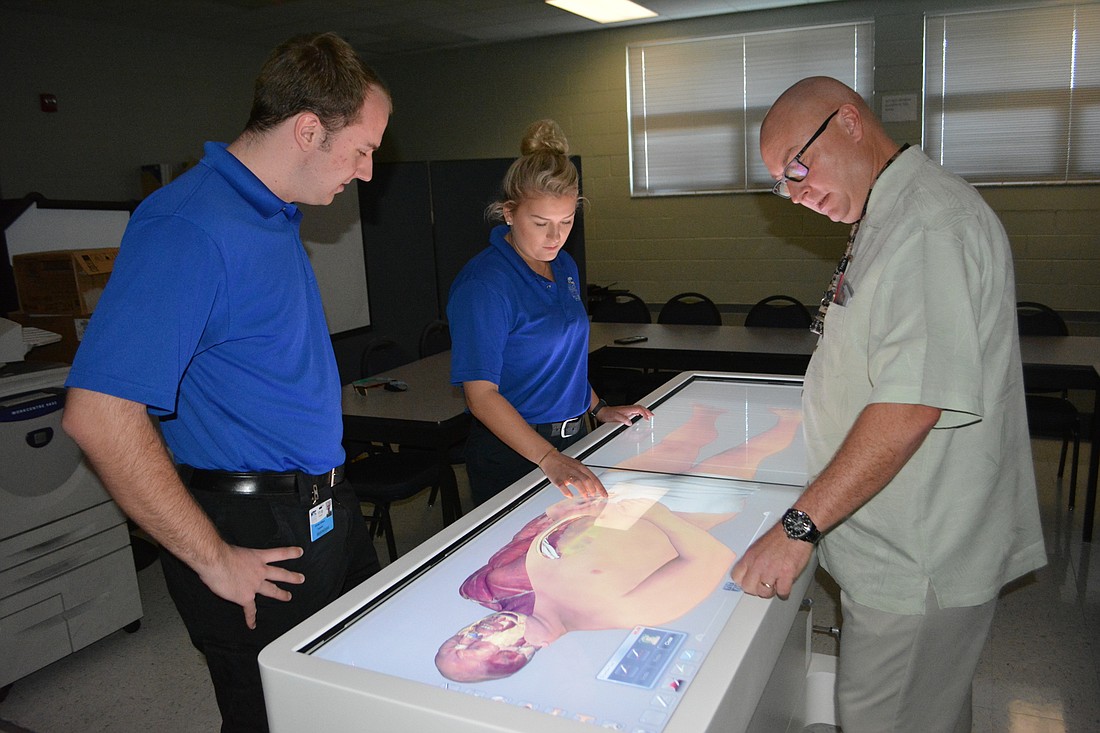- May 7, 2024
-
-
Loading

Loading

It took a special kind of technology to bring a cadaver to life.
At the Manatee Technical College’s Lakewood Ranch campus, EMT and paramedic students are working with the Anatomage table, which made its debut Dec. 20.
Think The Magic School Bus without the bus. Or a highly advanced Operation game without the buzzer.
The Anatomage table is a serious piece of equipment — $82,000 worth of serious — and yet, it makes learning fun.
Paramedic students Nick Treffinger, of East County, and Lydia Wilkinson of Bradenton, were working on the Anatomage table Feb. 16 while Jay Bush, the Emergency Medical Services program director at MTC, was explaining the table’s qualities.
Wilkinson kept inching closer to the table, then would reach out with her finger, slide it down the table and explore another of the table’s capabilities.
“She can’t keep her hands off it,” Treffinger said of his fellow student.
Indeed, that is what makes it so valuable to the program.
“I’m more of a hands-on person than somebody who likes to read a book,” Wilkinson said. “With this, there are so many things you can do. I learn by doing. It’s a fun way of learning.”
The Anatomage is billed as an 8-foot iPad that allows students and instructors to move within all parts of the human anatomy. It can teach lessons about the skin, muscle, bone, systems and organs with a touch.
Real cadavers were used to create the software used by Anatomage. Those cadavers were flash frozen, cut into 0.2-millimeter slices and photographed. The photos were stacked to re-create segmented 3-D anatomy. Anatomage helps students visualize beating hearts, respiration and traumatic injuries such as fractures or gunshot wounds.
“This technology gives our students the opportunity to learn gross anatomy on virtual human cadavers,” Bush said.
MTC is the first technical college in Florida to use the technology. Bush said 16 medical schools in Florida use an Anatomage table, which uses Windows 7 software. He said about 4,000 Anatomage tables are used throughout the world.
“Cadaver labs are expensive, and they have legal nightmares,” Bush said. “And these are actual bodies. The students can see what a heart looks like. They can see a valve in the heart. It’s such a hands-on thing and it definitely holds their attention.”
David Ratcliffe, an emergency room doctor with Manatee Memorial Hospital and medical director for the Emergency Services programs at MTC, said Anatomage is among the most amazing educational tools he has experienced.
“Having been exposed to anatomy through the usual medical school curriculum involving cadavers, this device allows the body to be studied layer by layer, organ by organ, or system by system,” Ratcliffe said.
Bush said other programs at MTC already are using the Anatomage table as well as high school students.
The cadavers used by Anatomage were all young when they died, which Bush said, is sad. But he said the result is vibrant anatomy.
With a flick of a finger, a student or instructor can spin the heart around to see it from different angles, or can peel away a layer to take a closer look inside.
“It’s not a picture of a heart valve,” Bush said. “It is the valve.”
He said the result is that “we can’t get students out of the room.”
It also allows him to “push our students to the max.”
One of the cadavers is so vibrant some of the students are calling him “Andy.”
“The detail is amazing,” Bush said. “I started messing with it as soon as it came in.”
Unfortunately, since the technology is so new, Bush said the instructors learn new capabilities each day on the table, which can be flat or can be shifted to a vertical position. All the MTC instructors were given an eight-hour course on Anatomage, but a wealth of on-the-job learning remains.
Dave Nasworthy, an EMT and paramedic instructor at MTC, said the software contains more than 2,000 images besides the four cadavers. “The students can explore things that can go wrong in the body,” he said. “They can see what a real aneurysm looks like.”
Clinical Coordinator Keith Lock noted, “We have just scratched the surface. This brings everything to life after a lecture. You can talk about something, then bring them into the room and virtually show them. It fills in the gaps.”